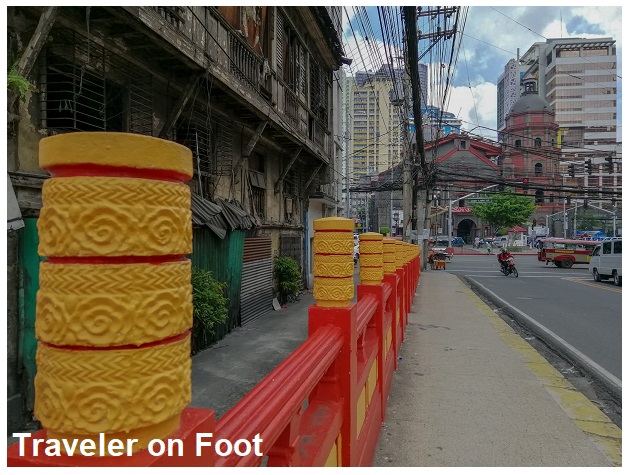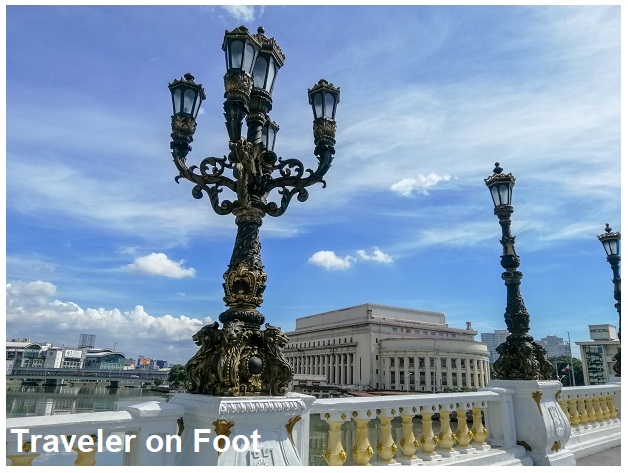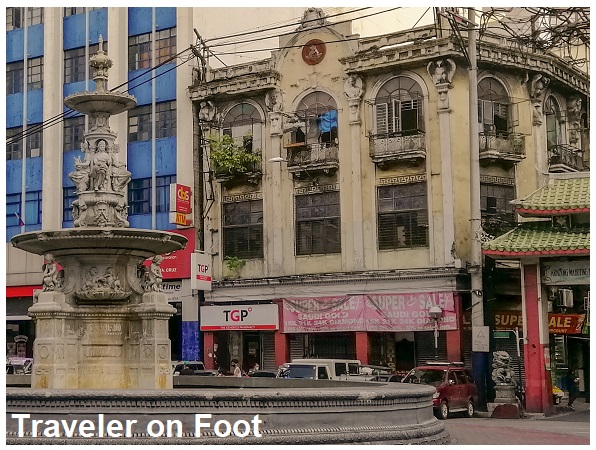A QUICK TRIP DOWNTOWN. I miss doing random walking tours. The health risk brought by the fatal virus limited travel only to get the essentials. In one of my trips to downtown Manila, I was able to squeeze in between errands a cultural walking tour around its heritage district.
The term downtown Manila is hardly used in our contemporary time and depending on the period in our history, the title downtown shifted from Binondo to Sta. Cruz and then to Quiapo.
PLAZA CALDERON DE LA BARCA. In the mid-19th century, downtown Manila would be Plaza Calderon Dela Barca in Binondo and San Nicolas District. This open space was named after a Spanish playwright and has changed names several times. The historian Teodoro Agoncillo described Plaza Calderon dela Barca as one of the most impressive open spaces of old Manila. It was landscaped with trees, Rococo water fountains on each end, and it was surrounded by equally impressive buildings, Hotel de Oriente and La Insular Cigar Factory.
We can only imagine these structures illustrated in old prints as an assemblage of architectural styles from Neo-Mudéjar to Belle Époque. Both buildings designed by the Spanish architect Juan Jose Huervas y Arizmendi were casualties of fire and World War II. What remain of the glorious days of Plaza Calderon dela Barca are the twin fountains and Binondo Church.
GLORY DAYS OF THE MUELLES. At the end of Calle Rosario in today’s Quintin Paredes Street is the site of Puente de España. It was replaced after the war by the recently refurbished Jones Bridge with its faux-Belle Époque lamposts and restored allegorical sculptures from its pre-war Juan Arellano-design reincarnation.
A view from the bridge is a cluster of pre-war buildings Edificio El Hogar Filipino and First National City Bank along Muelle de Industria. The thriving trade along the wharves led to the construction of warehouses and office buildings in the neo-classical and beaux arts architecture that were fashionable during the 1910s.
FUENTE DE CARRIEDO. During the American era the bustle of business would shift from Binondo to Sta. Cruz. Before the Lacson statue was erected, Plaza Goiti was the center of the city’s transportation network, where the tranvias ferried commuters to old Manila‘s major thoroughfares. The gentry and businessmen gathered to share the latest news before it broke on the porticos of the Neo-Classical Roman Santos Building where President Manuel Quezon worked as a clerk before starting his political career.
Plaza Sta. Cruz was center for entertainment like bars and vaudeville. The centerpiece of the Plaza Sta. Cruz is the 19th century Carriedo Fountain, which honors the legacy of philanthropist Don Francisco Carriedo y Perredo who left in his will the establishment of the first waterworks system for Manila. During my quick walking tour, I was able to say a prayer before the centuries-old image of the Nuestra Señora del Pilar in Sta. Cruz Church. Took a selfie in the Carriedo Fountain with the Monte de Piedad building in the background.
JAZZ AGE ESCOLTA. Across the street from the right side of Sta. Cruz Church is Calle Escolta, the country’s premier shopping destination during its heyday in the 1930s jazz age. Standing proud sentinels at the entrance of Manila’s historic high street are the Art Deco First United Building and the Beaux-Arts Regina Building.
I walked inside the pre-war First United Building to check out the retail stores with bespoke and artisanal products. One store sells original merchandise from pre-war Berg’s Department Store. I had a cold brew coffee while jazz music is being played in The Den.
EPILOGUE: ISANG SAGLIT IN PLAZA MIRANDA. In less than two hours of walking and doing errands, I ended up in Plaza Miranda. After the war, Downtown Manila was Plaza Miranda and all the streets leading to it. The transformation of Quiapo from a genteel arrabal to a rugged downtown began when the Friday devotions to Black Nazarene intensified to a city wide cult among the masses.
Later on, Plaza Miranda became a crossroad where political debates were staged and the people judged who to elect as leaders of the nation. The popular history, iconic landmarks and relevance of Quiapo to daily commuters and its street vendors, earned its enduring title up to this day as Downtown Manila.










Thanks for this blog. It was a welcomed break from the usual pandemic news. For a moment, I could imagine being able to do this tour too.
Thank you for visiting Traveler on Foot, Marilyn. I’m also thankful that I was able to go around recently.
Your photography is outstanding. I especially love the photo of Binondo Church with the fountain in the foreground.
Thanks Nicky. It’s been a while that I wasn’t able to share a travel story because of the lockdowns. Thank God I was able to walk around unscathed.